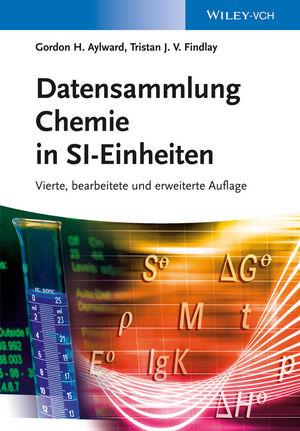
Sofort lieferbar (Download)
Man möchte vor dem Experiment die Wärmeentwicklung einer Reaktion abschätzen, eine neue Syntheseidee auf Plausibilität prüfen oder die Kenngrößen einer neuen Substanz in Beziehung zu bereits bekannten setzen - dies bedeutet meist für jeden Wissenschaftler einen zeitaufwendigen Besuch in der Bibliothek. Denn wie oft basieren die Daten auf unterschiedlichen Bezugssystemen, sind in landestypischen Nicht-SI-Einheiten angegeben und erfordern mehrmaliges Umrechnen.
Diese kompakte Datensammlung enthält genau die Werte, die jeder Chemiker immer wieder benötigt. Alle Daten stehen untereinander in Beziehung und sind aufeinander abgestimmt. Für alle Größen werden die SI-Einheiten verwendet, doch sind natürlich die entsprechenden Umrechnungsfaktoren für Nicht-SI-Einheiten angegeben. Dass diese Neuauflage auf dem neuesten Stand ist und Sicherheitshinweise enthält, versteht sich von selbst.
Diese kompakte Datensammlung enthält genau die Werte, die jeder Chemiker immer wieder benötigt. Alle Daten stehen untereinander in Beziehung und sind aufeinander abgestimmt. Für alle Größen werden die SI-Einheiten verwendet, doch sind natürlich die entsprechenden Umrechnungsfaktoren für Nicht-SI-Einheiten angegeben. Dass diese Neuauflage auf dem neuesten Stand ist und Sicherheitshinweise enthält, versteht sich von selbst.
Inhaltsverzeichnis
Das Internationale Einheitensystem (SI)
Grundlegende Konstanten (Revision 1986)
Wichtige Umrechnungsfaktoren
Eigenschaften der Elemente
Eigenschaften anorganischer Verbindungen
Eigenschaften organischer Verbindungen
Einige Kristallstrukturen
Strukturen einiger Moleküle und Ionen
Bindungslängen
Bindung-Dissoziationsenthalpien bei 25°C
Mittlere Bindungsenthalpien bei 25°C
Elektronegativitäten der Elemente (Pauling-Skala)
Schmelz-, Verdampfungs- und Atomisierungsenthalpien
Sukzessive Ionisierungsenthalpien der Elemente bei 25°C
Periodischer Trend der ersten Ionisierungsenthalpien
Elektronenaffinitäten bei 25°C
Gitterenthalpien ionischer Kristalle bei 25°C
Neutralisationsenthalpien
Löslichkeitsprodukte bei 25°C
Stabiliätskonstanten
Elektroden-Standard-Potentiale und Redoxgleichgewichte in wäßriger Lösung bei 25°C
Dissoziationskonstanten von Säuren und hydratisierten Metallionen
Gebräuchliche Säure-Base-Indikatoren
Ionische Eigenschaften des Wassers
Molare Leitfähigkeit wäßriger Lösungen bei 25°C
Molare Leitfähigkeit bei unendlicher Verdünnung bei 25°C
Löslichkeit von Gasen in Wasser
Erhöhung der Siedetemperatur und Erniedrigung der Gefriertemperatur (ebullioskopische und kryoskopische Konstanten)
Kritische Konstanten und Tripelpunkte ausgewählter Substanzen
Dampfdruck und Dichte von Wasser und Quecksilber bei verschiedenen Temperaturen
Dichte wäßriger Lösungen bei 25°C
Infrarot-Absorptionsfrequenzen
NMR: Chemische Verschiebungen
Elektronenkonfiguration der Elemente
Das Griechische Alphabeth
Numerische Präfixe
Anhang zu den Tabellen 5 und 6
R-Sätze (Gefahrenhinweise)
S-Sätze (Sicherheitsratschläge)
Grundlegende Konstanten (Revision 1986)
Wichtige Umrechnungsfaktoren
Eigenschaften der Elemente
Eigenschaften anorganischer Verbindungen
Eigenschaften organischer Verbindungen
Einige Kristallstrukturen
Strukturen einiger Moleküle und Ionen
Bindungslängen
Bindung-Dissoziationsenthalpien bei 25°C
Mittlere Bindungsenthalpien bei 25°C
Elektronegativitäten der Elemente (Pauling-Skala)
Schmelz-, Verdampfungs- und Atomisierungsenthalpien
Sukzessive Ionisierungsenthalpien der Elemente bei 25°C
Periodischer Trend der ersten Ionisierungsenthalpien
Elektronenaffinitäten bei 25°C
Gitterenthalpien ionischer Kristalle bei 25°C
Neutralisationsenthalpien
Löslichkeitsprodukte bei 25°C
Stabiliätskonstanten
Elektroden-Standard-Potentiale und Redoxgleichgewichte in wäßriger Lösung bei 25°C
Dissoziationskonstanten von Säuren und hydratisierten Metallionen
Gebräuchliche Säure-Base-Indikatoren
Ionische Eigenschaften des Wassers
Molare Leitfähigkeit wäßriger Lösungen bei 25°C
Molare Leitfähigkeit bei unendlicher Verdünnung bei 25°C
Löslichkeit von Gasen in Wasser
Erhöhung der Siedetemperatur und Erniedrigung der Gefriertemperatur (ebullioskopische und kryoskopische Konstanten)
Kritische Konstanten und Tripelpunkte ausgewählter Substanzen
Dampfdruck und Dichte von Wasser und Quecksilber bei verschiedenen Temperaturen
Dichte wäßriger Lösungen bei 25°C
Infrarot-Absorptionsfrequenzen
NMR: Chemische Verschiebungen
Elektronenkonfiguration der Elemente
Das Griechische Alphabeth
Numerische Präfixe
Anhang zu den Tabellen 5 und 6
R-Sätze (Gefahrenhinweise)
S-Sätze (Sicherheitsratschläge)
Produktdetails
Erscheinungsdatum
06. Mai 2014
Sprache
deutsch
Auflage
4. Auflage
Seitenanzahl
240
Dateigröße
23,64 MB
Autor/Autorin
Gordon H. Aylward, Tristan J. V. Findlay
Verlag/Hersteller
Kopierschutz
mit Adobe-DRM-Kopierschutz
Produktart
EBOOK
Dateiformat
EPUB
ISBN
9783527683253
Entdecken Sie mehr
Pressestimmen
" Ein hilfreicher Begleiter für Seminare und im Labor, sowie beim Protokolle schreiben. "
Amazon. de (13. 04. 2014)
" Diese kompakte Datensammlung enthält genau die Werte, die jeder Chemiker und auch Praktiker immer wieder benötigt. "
Metall (#4-2014, 01. 04. 2014)
" Abschließend lässt sich daher sagen, dass es sich lohnt sich fürs Studium ein solches Tabellenwerk zuzulegen (?) ich bin mit meinem Exemplar vollkommen zufrieden und werde es weiterhin mit Freude im Labor verwenden. "
Amazon. de (30. 05. 2014)
" Übersichtlich strukturierte Tabellen ermöglichen ein schnelles Nachschlagen und für alle Größen werden neben den SI-Einheiten auch die Umrechnungsfaktoren für Nicht-SI-Einheiten angegeben. "
Chemanager-online. com (17. 02. 2014)
Amazon. de (13. 04. 2014)
" Diese kompakte Datensammlung enthält genau die Werte, die jeder Chemiker und auch Praktiker immer wieder benötigt. "
Metall (#4-2014, 01. 04. 2014)
" Abschließend lässt sich daher sagen, dass es sich lohnt sich fürs Studium ein solches Tabellenwerk zuzulegen (?) ich bin mit meinem Exemplar vollkommen zufrieden und werde es weiterhin mit Freude im Labor verwenden. "
Amazon. de (30. 05. 2014)
" Übersichtlich strukturierte Tabellen ermöglichen ein schnelles Nachschlagen und für alle Größen werden neben den SI-Einheiten auch die Umrechnungsfaktoren für Nicht-SI-Einheiten angegeben. "
Chemanager-online. com (17. 02. 2014)
Bewertungen
0 Bewertungen
Es wurden noch keine Bewertungen abgegeben. Schreiben Sie die erste Bewertung zu "Datensammlung Chemie in SI-Einheiten" und helfen Sie damit anderen bei der Kaufentscheidung.







